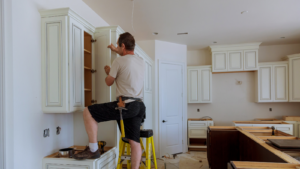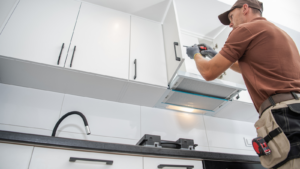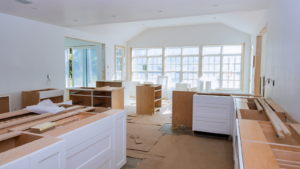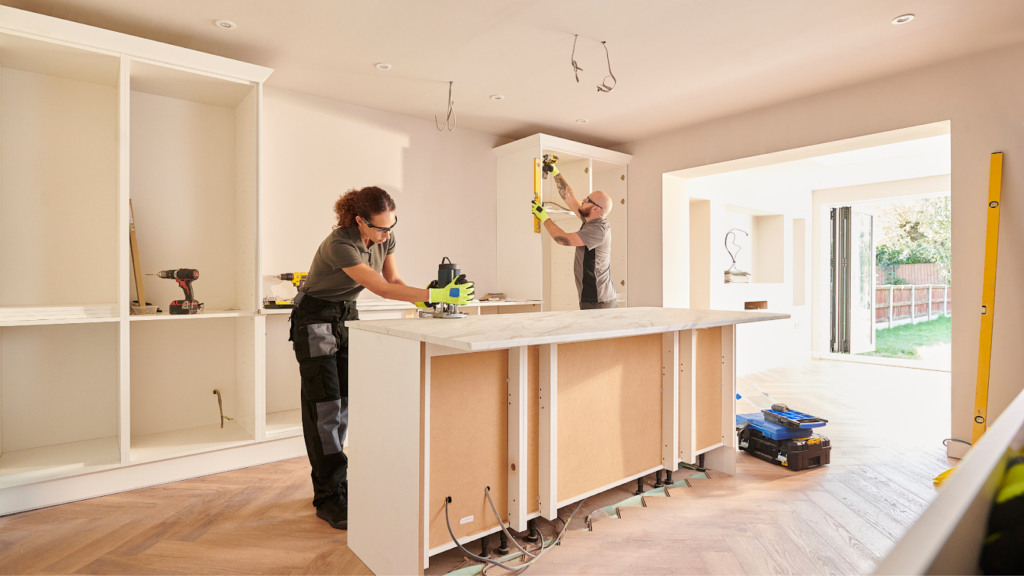
Ready to breathe new life into your kitchen? Refurbishing kitchen cabinets is a cost-effective and transformative approach. It’s an opportunity to add a fresh splash of color, update hardware, or even change the entire look of your kitchen without breaking the bank.
Refurbishing Kitchen Cabinets
Evaluating kitchen cabinets for signs of wear or damage provides clarity to homeowners on whether refurbishing or outright replacement offers the most optimal solution.
Signs Your Cabinets Need Refurbishing
Multiple indicators suggest whether kitchen cabinets require refurbishing. Telltale signs include chipped or faded paint, damaged hardware such as hinges, or doors refusing to close correctly. Deterioration, when observed in the cabinet body, often takes the form of water damage, stains, or swollen plywood.
Deciding Between Refurbishing and Replacing
Choosing whether to refurbish or replace kitchen cabinets depends considerably on their state and the homeowner’s preferences. Essential factors include structural stability, design satisfaction, and budget constraints.
To illustrate, structurally stable cabinets showing only superficial damage are excellent candidates for refurbishing.
Planning Your Refurbishing Project

Planning a kitchen refurbishment project turns complex tasks into manageable steps. This strategy avoids misunderstandings and streamlines the refurbishing process.
Setting a Budget for Refurbishing
Determining a budget before starting the project ensures a smooth refurbishing process. Many homeowners overlook this essential step, leading to overspending and sky-rocketing costs. Consider factors like the price of materials and labor costs when calculating the budget.
Choosing a Style and Color Scheme
The next step involves selecting a kitchen design style and color scheme for your refurbished kitchen cabinets. From traditional to modern styles, the choices are vast.
Timeline Considerations for DIY vs Professional Work
Lastly, evaluate the time required for both DIY and professional kitchen cabinet refurbishing. A DIY venture may take longer, depending on the individual’s skill level. For a small kitchen, one could spend around 1-2 weeks on a DIY project.
Step-by-Step Guide to Refurbishing Kitchen Cabinets

Refurbishing kitchen cabinets involves a detailed and well-planned procedure. Each step requires attention, time, and patience for effective results.
Cleaning and Preparing the Cabinets
Initial efforts in refurbishing kitchen cabinets revolve around cleaning and preparation. It involves removing grime, grease, and dust accumulated over the years.
- Start by emptying the cabinets, removing any items inside.
- Detach the doors and drawers for easy access and separate cleaning.
- Use a robust cleaning agent, like trisodium phosphate (TSP), that effectively removes dirt.
- After cleaning, repair any surface flaws. For instance, fill dents, holes, and scratches with wood filler.
Sanding and Priming the Surfaces
Sanding and priming are foundational steps that significantly affect the final look of the cabinets.
- Sanding removes any remaining old finish and creates a smooth surface for priming. Using 100-grit sandpaper achieves this.
- Priming prepares the cabinet for paint or stain, fostering better adhesion. A coat of stain-blocking primer ensures a smooth and resilient surface.
Selecting the Right Paint or Stain
Choosing the right paint or stain is a central part of the refurbishing process. It primarily defines your cabinets’ appearance and durability.
- For a modern and smooth finish, opting for acrylic or enamel based paint provides an excellent result.
- Stain options offer a classic look. Oil-based stains penetrate deeply, providing consistency and durability.
Applying the Finish
The final step involves applying the selected paint or stain. Here’s how this is done most effectively:

- Stir the paint or stain well before and during application to ensure uniformity.
- Use small, flat brushes for more precise application.
Must know
Refurbishing kitchen cabinets isn’t just a cost-effective way to spruce up your kitchen. It’s an opportunity to breathe new life into your space, adding charm and character. The key to making those refurbished cabinets last lies in the trifecta of regular cleaning, protective measures, and timely touch-ups. With a little effort, it’s possible to maintain their appeal and longevity. Remember, the right care can make a world of difference, whether it’s using mild soap for cleaning, applying protective coatings, or installing bumpers.
